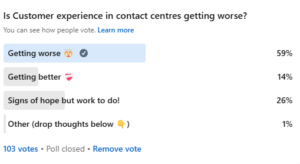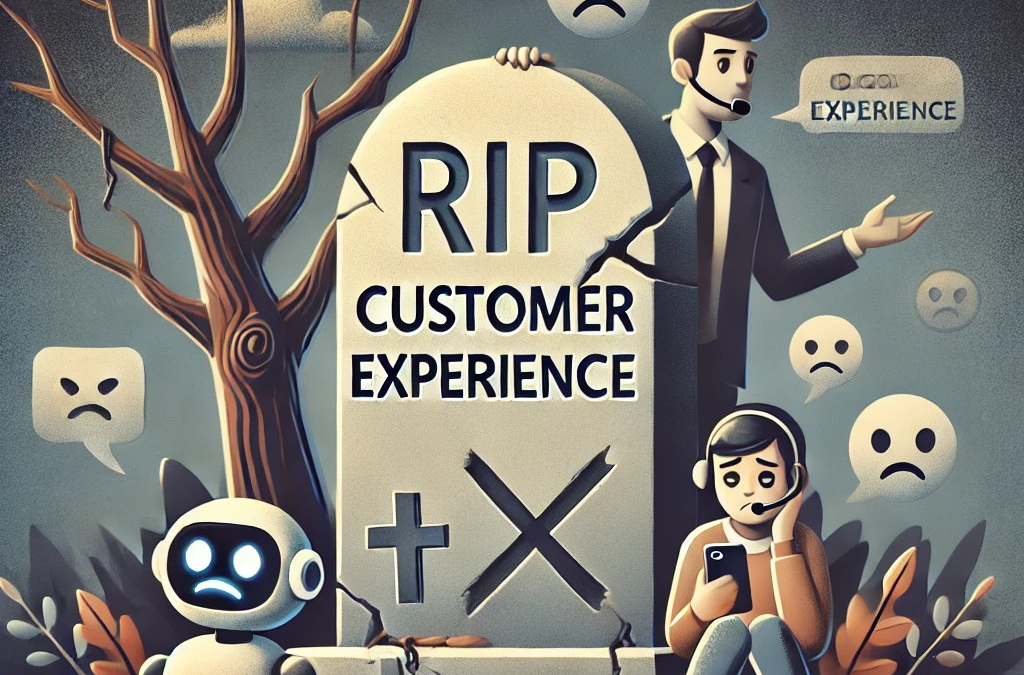Customer experience (CX) in contact centres has been a pressing issue for a long time, but now as more businesses lean on technology to manage customer interactions, from challenging Voice calls, live digital web chatting, to AI-driven chatbots, the question remains: is the experience getting worse or are there glimmers of hope for improvement?

A poll conducted by FAB Solutions Founder Garry Gormley in September 2024 adds fuel to this discussion. With over 100 respondents, the results clearly show that a majority—59%—believe that customer experience in contact centres is “getting worse.” Meanwhile, only 14% of respondents felt things were “getting better,” while 26% expressed that there are “signs of hope but work to do.”
This indicates a strong sentiment that while some improvement efforts may be underway, many believe that customer experience still has a long way to go. Only 1% offered alternative opinions, reflecting the consensus that significant issues exist.
A Closer Look at the Challenges
Many businesses today are focused on improving their digital strategies, especially through self-service, automation, and AI. The goal is to deflect demand from live agents, but customer feedback suggests that this approach might be missing the mark. As Kevin Still of Kevin Still Consulting explains, “If we put on our ‘consumer’ hat rather than ‘corporate’ hat, then reflect on recent engagements with our providers, you get a sense of how much things have deteriorated. Mediocre service is now acceptable if it gets the job done.”
This sentiment resonates with the frustrations many consumers face when interacting with services like banking or telecoms. Still’s experience illustrates how difficult it can be to even reach a human agent or receive timely support, especially during critical issues like a banking failure.
The Digital First Dilemma

The drive toward a “digital-first” approach might be causing more harm than good in terms of overall CX. While businesses see digital transformation as a way to streamline operations and cut costs, customers often feel frustrated by clunky self-service systems and unhelpful chatbots.
Jonathan Creese, Customer Experience manager at Gillies, shares this concern, stating, “I think far too many companies are obsessed with AI and Bots, investing too much money into this technology which is not making the promised improvements. It is not to say AI does not have a role to play, but we must not undermine what customers truly want…a real person at the other end of the phone/computer.”

Peter Ryan, Global BPO Advisor at Ryan Strategic Advisory agrees, adding that the issue stems from underfunded contact centres and a focus on cost-cutting measures. “The forced self-service and poorly deployed automation are major pain points hurting satisfaction levels,” he says. Ryan also points out that many agents are doing their best to help customers, but their efforts are often thwarted by limited resources and ineffective tools.

Empowering the Frontline – Another major issue highlighted in the poll and by contributors is the lack of empowerment among frontline agents. Nichola Hall, Regional Vice President at Arctic Wolf, notes that “businesses are not empowering their frontline teams to make decisions for the situation the customer is in. Too many processes, which only benefit the business, are evident. Some companies make the barrier to exit so high and complicated that I believe they count on the fact most people will just give up and stay put after a bad experience.” This creates a vicious cycle where customers feel trapped, and businesses lose the motivation to improve their offerings.
What Needs to Change?
For businesses to reverse this downward trend, they need to focus on three key areas:
Listen to Customers: Companies must use insights and data to better understand what their customers want and how they prefer to engage. Kevin Still emphasises the importance of viewing the issue through the “consumer” lens, reminding businesses that customer perspectives are critical for shaping effective strategies
 Fix the Basics: Capacity management, clear processes, and robust resource planning need to be in place. Ensuring that teams are adequately trained and that there are no clunky workarounds is crucial for delivering a seamless experience. Yasas Illeperuma, Co-founder at XpertCX Solutions stresses the importance of staff training, stating, “The first priority should be educating all staff about the core business and the company’s vision.”
Fix the Basics: Capacity management, clear processes, and robust resource planning need to be in place. Ensuring that teams are adequately trained and that there are no clunky workarounds is crucial for delivering a seamless experience. Yasas Illeperuma, Co-founder at XpertCX Solutions stresses the importance of staff training, stating, “The first priority should be educating all staff about the core business and the company’s vision.”
Balance Innovation and Human Touch: While AI and automation are valuable tools, they should not replace human interaction when it’s necessary. As JaaKko Jutila, Vice President of Basware points out, “There are no shortcuts. Implementing AI, chatbots, or self-service solutions without adequate maturity can result in a subpar customer experience.” Jaakko goes on to add that the drivers to CX are ultimately born from customer choice and that in his view “customers increasingly prefer to handle tasks independently and that when human interaction is necessary, customers still value speaking with real people.”
President of Basware points out, “There are no shortcuts. Implementing AI, chatbots, or self-service solutions without adequate maturity can result in a subpar customer experience.” Jaakko goes on to add that the drivers to CX are ultimately born from customer choice and that in his view “customers increasingly prefer to handle tasks independently and that when human interaction is necessary, customers still value speaking with real people.”
Is There A Glimmer of Hope?
Despite the pessimism reflected in the poll, 26% of respondents believe there are “signs of hope but work to do.” This suggests that while the current situation is far from perfect, there is potential for improvement if businesses can strike the right balance between technology and human interaction.
So to summarise, improving customer experience in contact centres will require a multifaceted approach that not only embraces digital innovation but also empowers agents and listens closely to customer feedback. Only then can businesses hope to reverse the downward trend and deliver the level of service that customers truly expect and deserve.
